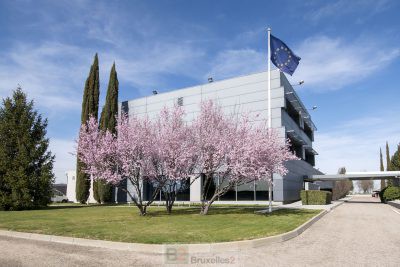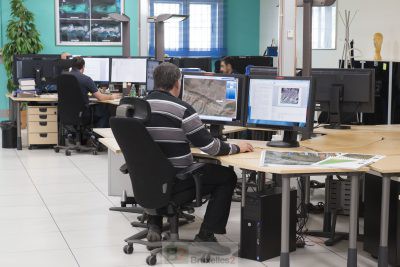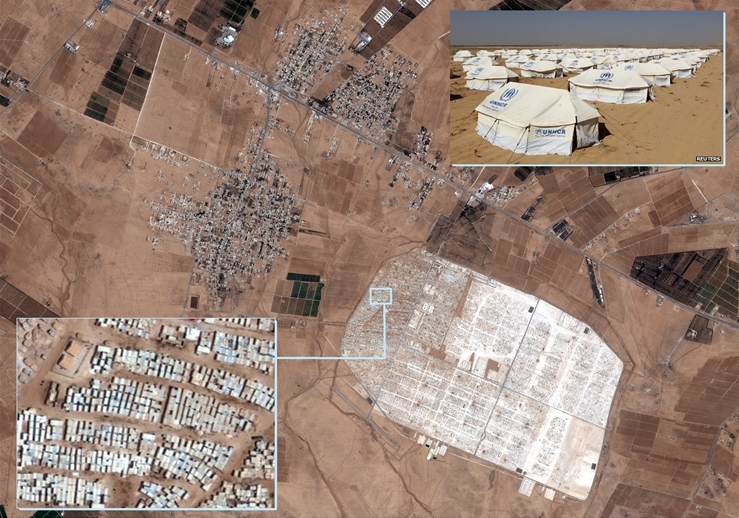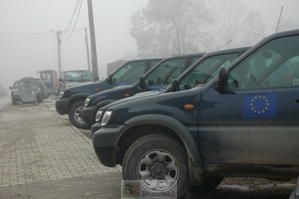At the heart of European satellite intelligence, the SatCen

(B2 in Madrid - exclusive) Whether it's sending humanitarian aid to Kabul, organizing the visit of UN observers to Syria, intervening after a natural disaster like in Haiti, or to monitor the flow of migrants in Libya, all these operations can go through Madrid at some point.
A white building in the Madrid suburbs
It is, in fact, in the suburbs of the Spanish capital that the European Union Satellite Center (abbreviated to SatCen) is established. In a discreet white building, located on the air base of Torrejón de Ardoz, to which B2 has been authorized to enter, about forty analysts work 24 hours a day, 24 days a week to provide, when necessary, intelligence analyzes to the Service. European Union for External Action, missions and operations of the European Union, the UN and the OSCE.
Analysts at the heart of the effervescence
Although it is only one of three players in the European Union's intelligence cycle, the SatCen, and the information it provides, is nevertheless a crucial element in all operational decisions taken in Brussels. In the center, the effervescence is daily. Its "clients", and their centers of interest, are so diverse that there are only a few days without an emergency erupting. Added to this is the long-term work. Monitoring migratory flows in North Africa or further east, in support of the Frontex agency or Operation Sophia, represents a quarter of the center's activity (read: To monitor migratory flows, the SatCen called to the rescue). The workload is equivalent for monitoring the situation in Ukraine, this time in support of the OSCE.
High level security
Upon entering the premises, one is struck by the security measures, with many security systems, protection, cameras... including electromagnetic signal detectors to know if there is equipment in emissions, which could transmit sensitive information. Justified protection for the director of the center, Pascal Legai. " I We sometimes handle data classified as “secret” and, even when it is not classified, it is highly sensitive. [...] A telephone could be used by anyone to listen to what is being said in this room »
The coffee break... short
Everyone is focused, whether in the operating room or in the IT (information technology) or CapDev (capability development). Here, the coffee break is rather short. No question of dragging too much. In the SatCen operating room, which is relatively large and spacious, the teams are organized by islands, with three or four desks, without partitions. At the bottom, is the team in connection with the "customers" and the suppliers (of images).
A crucial step
They are the ones who receive calls and orders from "customers". It is also up to them to define, with the team leaders, the images necessary to respond to the order, and to call the suppliers, who may be civilian or military, with whom a direct line is established 24 hours a day, 24 days a week. 7. This step is crucial, because all the work of the analysts will depend on the images on which they will work. Responsiveness is key. For the most express requests, this whole step only takes a few minutes. For other types of requests, for long-term analyses, the process is more complete, more mature...
From satellite to analysis
The ordered images also arrive at rates adapted to the requests. Once the satellite images have been received, the analysts get busy. The first step is mainly computer. Thanks to computerized systems, an initial analysis is made. " A satellite image contains a wealth of information ". Items defined as unnecessary are " discriminated against ". Then comes the work of the man. This is the "real" added value of SatCen: its forty experts.
Human expertise, real added value of SatCen

This is the work of analysts, who are grouped according to their functions. The luminosity of the room is increased by the gleams of the three or four screens of each of the analysts. The silence is broken only by the sound of the "clicks" of fingers on keyboards and mice, and a few exchanges between experts. Here, the English language is required. A quick glance at this open space reveals the screens, where an abundant amount of highly sensitive information circulates. Some are classified Top Secret. But it's not just the confidential information that's interesting. Analysts are increasingly relying on open sources: Google Earth or social networks provide access to other types of information », often complementary.
Multitasking Experts
French, Germans, Czechs, Italians, Spaniards... and nationalities rub shoulders there with a naturalness that could shock the intelligence services of any country. The centre's policy is to develop the versatility of its experts. All must be"multitask"because having a 24/24 service means that everyone can be on call at some time. And everyone must therefore be able to respond to each customer's orders or questions.
(Leonor Hubaut)
To be continued... the rest of our report on the blog and on the pro
For further :
- our profile: The European Union Satellite Center (Satcen)
- To see the website of SatCen
The example of piracy
Off the coast of Somalia, satellite images thus make it possible to locate suspicious ships, but it is only with information from the field that it is possible to know that such and such a boat has a metal ladder at the stern. " It's not very useful for fishing but for a boarding, it's something else...Of course, caution is required on the credibility of these so-called "open" sources, often photos. It is nevertheless an essential instrument. It also gives the end user a more global view of the terrain.

